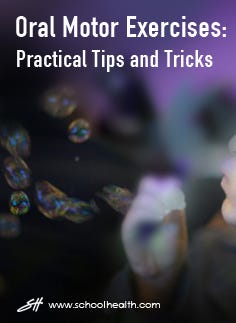- Home
- Oral Motor Exercises: Practical Tips and Tricks - Articles
- 866-323-5465
- Mon-Fri, 7am-5pm CST
- Need Help?
Oral Motor Exercises: Practical Tips and Tricks

It is important to have strong and mobile articulators. Articulators include our lips, cheeks, jaw and tongue. Children who are born prematurely, are diagnosed with various syndromes including Down syndrome or Autism, or are "late talkers" most often have weak muscles of the face. Development of oral motor skills includes teaching these muscles to move in the right way in order for the child to learn to swallow, chew and speak.
In the early childhood setting children with poor oral motor skills are easily identified. These children are often difficult to understand and are messy eaters. Some children drool excessively and grind their teeth. Many children demonstrate delayed speech skills with sloppy articulation of speech sounds.
Several individuals can play a role in helping young children to improve their oral motor skills. The speech pathologist may enlist the help of teachers and parents to create an intervention plan unique to the child. The plan may be used in conjunction with other speech approaches but does not replace the need for direct work on speech sound production.
In designing the oral therapy intervention plan, the speech and language pathologist may identify activities that include blowing horns, bubbles, and cotton balls; sucking or drinking; up-and-down tongue movements; licking, biting, or pushing on a tongue depressor with lips; or breathe control exercises. The intent of these exercises include:
-
Increasing the range, accuracy, power and rate of articulator movements
-
Enhancing the child's voluntary control of oral movements
-
Heightening the child's awareness of oral structures
-
Encouraging "reluctant children" to participate in therapy
There are several oral motor exercises that can be easily performed in a group preschool setting. When other children are involved, the exercises are viewed as fun "games" rather than therapy. The exercises below are designed for children ages 3 and up and are often used in an early childhood setting such as Head Start.
Whistle Straws and Pom Poms
The ability to blow is essential for sound production. Using whistle straws is important for lip protrusion, blowing, and sucking. These skills help create the vowel sounds "ooh" and "oh". For a fun game, the child can use the straw to blow various sized pom poms. The larger the pom pom, the harder it is to blow. If the child is a beginning blower, have the child blow the smallest pom poms without using the straw.
Blowing Bubbles
Blowing bubbles helps a child to coordinate their lips, cheeks, and jaw with airflow. This activity helps the child regulate the airflow necessary for speech production. Blowing bubbles can target several speech sounds such as "m" "p", "b", "g" and "f" and target many single words such as "uh-oh" "up" "pop" "big" "fly" and "go."
The Echo Microphone
Using an echo microphone works to improve tongue elevation and tongue range of motion as well as sequencing speech sounds and words together. You can also use it to work on sequencing consonant-vowel combinations, such as ("ta," "pa," "ka") or work on saying two syllables together such as "mama," "dada," and "papa." When the child has mastered the previous exercises, you can move on to practicing two syllable words, such as "popcorn," "birthday," and "baseball." For fun, encourage the child to sing a favorite song, like "Twinkle, Twinkle Little Star" or sing to music!
There are many benefits of playing oral motor games with young children. Three of the biggest benefits are increased speech output, increased speech sound variety and improved speech clarity.
Andrea Simpson, MS, CCC-A/SLP is a communications specialist for the Special Education District of McHenry County (SEDOM) Deaf and Hard of Hearing Program in Crystal Lake, IL. She is both a pediatric audiologist and speech and language pathologist.
For oral motor products, shop our Oral Motor category or shop our Early Childhood or Special Education categories.
